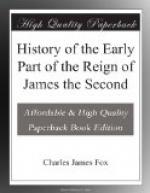The bonds being still refused, the government had recourse to an expedient of a most extraordinary nature, and issued what the Scotch called a writ of Lawburrows against the whole district. This writ of Lawburrows is somewhat analogous to what we call “swearing the peace” against any one, and had hitherto been supposed, as the other is with us, to be applicable to the disputes of private individuals, and to the apprehensions which, in consequence of such disputes, they may mutually entertain of each other. A government swearing the peace against its subjects was a new spectacle; but if a private subject, under fear of another, hath a right to such a security, how much more the government itself? was thought an unanswerable argument. Such are the sophistries which tyrants deem satisfactory. Thus are they willing even to descend from their loftiness into the situation of subjects or private men, when it is for the purpose of acquiring additional powers of persecution; and thus truly formidable and terrific are they, when they pretend alarm and fear. By these writs the persons against whom they were directed were bound, as in case of the former bonds, to conditions which were not in their power to fulfil, such as the preventing of conventicles and the like, under such penalties as the Privy Council might inflict, and a disobedience to them was followed by outlawry and confiscation.
The conduct of the Duke of Lauderdale, who was the chief actor in these scenes of violence and iniquity, was completely approved and justified at court; but in consequence probably of the state of politics in England at a time when the Whigs were strongest in the House of Commons, some of these grievances were in part redressed, and the Highlanders, and writs of Lawburrows were recalled. But the country was still treated like a conquered country. The Highlanders were replaced by an army of five thousand regulars, and garrisons were placed in private houses. The persecution of conventicles continued, and ample indemnity was granted for every species of violence that might be exercised by those employed to suppress them. In this state of things the assassination and murder of Sharp, Archbishop of St. Andrews, by a troop of fanatics, who had been driven to madness by the oppression of Carmichael, one of that prelate’s instruments, while it gave an additional spur to the vindictive temper of the government, was considered by it as a justification for every mode and degree of cruelty and persecution. The outrage committed by a few individuals was imputed to the whole fanatic sect, as the government termed them, or, in other words, to a description of people which composed a great majority of the population in the Lowlands of Scotland; and those who attended field or armed conventicles were ordered to be indiscriminately massacred.




